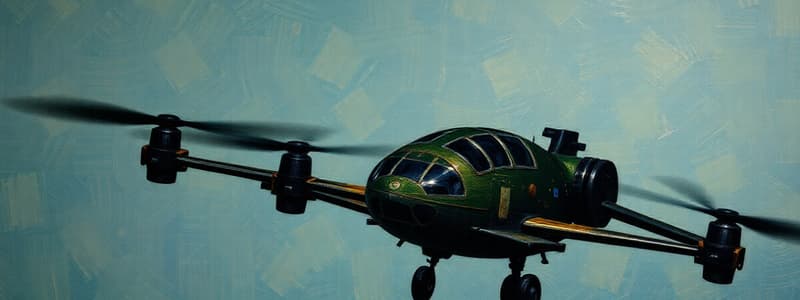Podcast
Questions and Answers
Which of the following best describes the primary focus of EMK310 concerning navigation algorithms for MARVs?
Which of the following best describes the primary focus of EMK310 concerning navigation algorithms for MARVs?
- In-depth analysis of various controller theories.
- Implementation of advanced control strategies.
- Implementation of rudimentary controllers for track following. (correct)
- Mathematical modeling and simulation of control systems.
An open-loop control system utilizes feedback to correct deviations from the intended path.
An open-loop control system utilizes feedback to correct deviations from the intended path.
False (B)
In the context of MARV navigation, what is the primary disadvantage of relying solely on an open-loop control strategy?
In the context of MARV navigation, what is the primary disadvantage of relying solely on an open-loop control strategy?
Inability to correct for errors or external disturbances.
In a feedback control system, the actual output is compared to the ______ to determine the error.
In a feedback control system, the actual output is compared to the ______ to determine the error.
Match the following control elements with their respective functions in a PID controller:
Match the following control elements with their respective functions in a PID controller:
What is the primary characteristic of on-off control that leads to potential issues in MARV navigation?
What is the primary characteristic of on-off control that leads to potential issues in MARV navigation?
Hysteresis in on-off control reduces overshoot error but increases oscillation.
Hysteresis in on-off control reduces overshoot error but increases oscillation.
Explain how inertia contributes to overshoot in a MARV using on-off control.
Explain how inertia contributes to overshoot in a MARV using on-off control.
The integral term in a PID controller helps to eliminate ______ error.
The integral term in a PID controller helps to eliminate ______ error.
Match the following environmental conditions with their potential impact on MARV navigation:
Match the following environmental conditions with their potential impact on MARV navigation:
Why is derivative control highly sensitive to measurement noise?
Why is derivative control highly sensitive to measurement noise?
A PI controller is more complex than a full PID controller.
A PI controller is more complex than a full PID controller.
What is the primary advantage of using proportional control over on-off control?
What is the primary advantage of using proportional control over on-off control?
The ______ term in a PI controller offsets the effects of using only the proportional component.
The ______ term in a PI controller offsets the effects of using only the proportional component.
Match the following controller types with their primary characteristics:
Match the following controller types with their primary characteristics:
What distinguishes Model Predictive Control (MPC) from other control strategies discussed?
What distinguishes Model Predictive Control (MPC) from other control strategies discussed?
Computer simulation of a control algorithm in MPLABX requires the use of programming languages such as Python.
Computer simulation of a control algorithm in MPLABX requires the use of programming languages such as Python.
What should MARV's sensors do in conjunction with on-off control?
What should MARV's sensors do in conjunction with on-off control?
For MARV to turn left with on-off control with differential motor control, the ______ motor will be switched off.
For MARV to turn left with on-off control with differential motor control, the ______ motor will be switched off.
Match the potential controller to the MARV's ability.
Match the potential controller to the MARV's ability.
Flashcards
Open-loop control
Open-loop control
Controller that outputs a control action based on a specific input without feedback.
Feedback control
Feedback control
Controller that adjusts its output based on feedback from the system's actual output.
On-off control
On-off control
Control using only two states which are fully on or fully off.
Overshoot (in control systems)
Overshoot (in control systems)
Signup and view all the flashcards
Oscillation (in control systems)
Oscillation (in control systems)
Signup and view all the flashcards
Dead band (hysteresis)
Dead band (hysteresis)
Signup and view all the flashcards
Proportional control
Proportional control
Signup and view all the flashcards
Derivative control
Derivative control
Signup and view all the flashcards
Integral Control
Integral Control
Signup and view all the flashcards
PI control
PI control
Signup and view all the flashcards
Model predictive control (MPC)
Model predictive control (MPC)
Signup and view all the flashcards
Study Notes
- Chapter 7 covers the design and implementation of a navigation algorithm, focusing on rudimentary controllers to allow a MARV to follow a track.
- Advanced controller theory is covered in Control Systems EBB320 and Automation EBT410.
Core Concept
- Control involves processing an input to achieve a desired output like matching a real-world device to a setpoint.
- A MARV's navigation system exemplifies a control system, processing sensor input to guide motor control for track following and position correction.
- Digital control systems on microcontrollers offer the advantage of producing complex output functions from inputs.
Microcontroller Implementation
- Microcontrollers read inputs from ports, ADC, and timers, processing digital codes to generate control signals for connected devices via interfaces like DAC and PWM.
- MARV subsystems utilize control, ranging from simple input-output mapping to sophisticated control with sensors and algorithms to follow a setpoint.
- An example start-up system maps a touch sensor input to system initialization and provides LED feedback.
- A communication system maps PC commands via RS232 to control LEDs, SSD, EEPROM, and the MARV's state.
- The sensor system is a free-running system that relies on errorless synchronisation between illuminating and sensing.
- The navigation system uses sensor input to control motors, enabling the MARV to maintain its position on the track.
Open-Loop Control
- Open-loop control outputs a control action based on a specific input, lacking feedback for performance certainty.
- An example of open-loop control would be programming a predetermined trajectory into the MARV's memory without sensor input.
- This type of control operates without sensors and lacks the ability to correct course deviations.
Feedback Control
- Feedback control uses sensors to detect deviations from the intended trajectory of the MARV, enabling course correction.
- A feedback controller compares the actual system output with the intended output (setpoint) to determine the error.
- Error is calculated as Setpoint - Process variable.
- Correction can be applied through on-off and PID control methods.
On-Off Control
- On-off control uses only two states: fully on or fully off, in order to control the system.
- For MARV with differential motor control, motors are either fully on or fully off to turn.
- Turning involves switching off one motor while the other keeps turning.
- The turning radius depends on the relative wheel location and wheel size.
- An additional control is added Motor can be switched on in reverse in order to perform a tighter turn.
- The two issues that affect the performance of an on-off controller are overshoot and oscillation.
Issues with On-Off control
- Overshoot is when the MARV corrects its course and then goes too far.
- Overshoot happens because the processing speed and inertia and the fact the motors can only be fully on or fully off.
- Inertia causes time lag between the sensor output and the real-time positioning of the system.
- Oscillation is linked to overshoot as the MARV "snakes" along the track.
- Oscillation can be mitigated by implementing a dead band (hysteresis) in the controller.
PID Control
- PID control elements have subsets such as proportional (P), proportional-derivative (PD) or proportional-integral (PI) control.
- The equation that describes how PID control is applied is:
- Output = G * (e(t) + Ki ∫ e(t) + Kd * d/dt e(t)) + M, where e(t) is setpoint - actual value.
- G, Ki, and Kd are constants and M is an offset.
Proportional Control
- When the derivative and integral elements omitted from PID controller, it reduces to a proportional controller.
- Proportional control varies the amount of control based on the error between setpoint and actual signal.
- Control action decreases as the error decreases.
- Effectiveness is maximized in a static environment.
- The sensor input being affected by ambient light is not a varying condition to be concerned about.
- Noise affects the controller because the controller will not have an accurate process variable on which to base the control.
- The advantage of using of proportional control over on-off, is that corrections to the MARV's course are gradual.
Derivative Control
- Derivative control is described by Output = (G x Kd) * d/dt e(t) + M.
- The derivative term measures how fast the error is changing, used in motion control as it allows the controller to quickly respond to changing inputs.
- Derivative control is very sensitive to measurement noise, making it more difficult to apply.
Integral Control- Integral term
- Increments the controllers output to reduce error and drive error to zero.
- Most common simplifications of PID controller is PI controllers that omit the derivative term to avoid issues with noise, in the process variable.
PI Control
- In a PI controller, the proportional term causes the output to follow the input
- The integral term pushes the output toward the setpoint, canceling the offset from proportional-alone control.
- Pl control is efective for the MARVs as the only changes that should occur when following the track are the bends at some places, and those can be easily navigated without derivative control.
Model Predictive Control (MPC)
- Model Predictive Control is a controller that is highly sophisticated.
- It uses a mathematical model of a system to determine its outputs, parameters are changed dynamically.
- Used because it is a common control strategy that may be implemented using a µC.
Control System Summary
- Pl and PD (not discussed) controllers are special cases of a PID controller where the derivative and integral constants respectively are zero.
- Proportional control results when integral and derivative terms are ignored.
- On-off control results when the gain of the proportional controller approaches infinity.
- Open loop results when the gain approaches zero.
- Issues to avoid are complexity, sampling loss of critical information, measurement delay, process delay, object delay, imperfect coupling, overshoot & oscillation, saturation or windup, noise sensitivity and discontinuous input.
NIBBLE on Rudimentary Navigation Control
- On-Off Control: understand the functioning of an on-off controller and the implications it has for controlling a system, the navigation of your MARV.
- Proportional control: Understand the functioning of a proportional controller and its implications for controlling a system, specifically the navigation of your MARV.
- Value added learning: learn the concept of simulation of a system & explore its functioning; paper simulation allows conceptual understanding; the computer simulation allows a quantitative approach to probe the system's operation/performance under conditions.
Studying That Suits You
Use AI to generate personalized quizzes and flashcards to suit your learning preferences.




